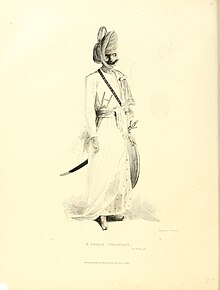कोली, કોલી, कोळी | |
|---|---|
 | |
| Regions with significant populations | |
| Rajasthan, Himachal Pradesh, Gujarat, Maharashtra, Uttar Pradesh, Haryana, Karnataka,Odisha,[1] Kashmir[2] | |
| Languages | |
| Hindi, Gujarati, Marathi, Bhil, Kachi Koli, Konkani, Kannada | |
| Religion | |
| Hindu, Muslim, Christian | |
| Related ethnic groups | |
| Kori, Koli Christians |
The Koli is an Indian caste that is predominantly found in India, but also in Pakistan and Nepal. Koli is an agriculturist caste of Gujarat but in coastal areas they also work as fishermen along with agriculture.
In the beginning of 20th century, the Koli caste was recognised as a denotified tribe under Criminal Tribes Act by the Indian Government because of their anti-social activities during World War I. The Koli caste forms the largest caste-cluster in Gujarat and Himachal Pradesh, comprising 24% and 30% of the total population in those states respectively.[3][4]
- ^ "Odisha – List of Scheduled Tribes" (PDF). ST & SC Development, Minorities & Backward Classes Welfare Department Government of Odisha. Archived from the original (PDF) on 19 August 2021. Retrieved 16 May 2021.
- ^ "Jammu and Kashmir BJP in favour of reservation for people living along international border". The New Indian Express. Archived from the original on 8 April 2019. Retrieved 8 April 2019.
- ^ Shah 2004, p. 221.
- ^ Minhas, Poonam (1998). Traditional Trade & Trading Centres in Himachal Pradesh: With Trade-routes and Trading Communities. Indus Publishing. ISBN 978-81-7387-080-4.